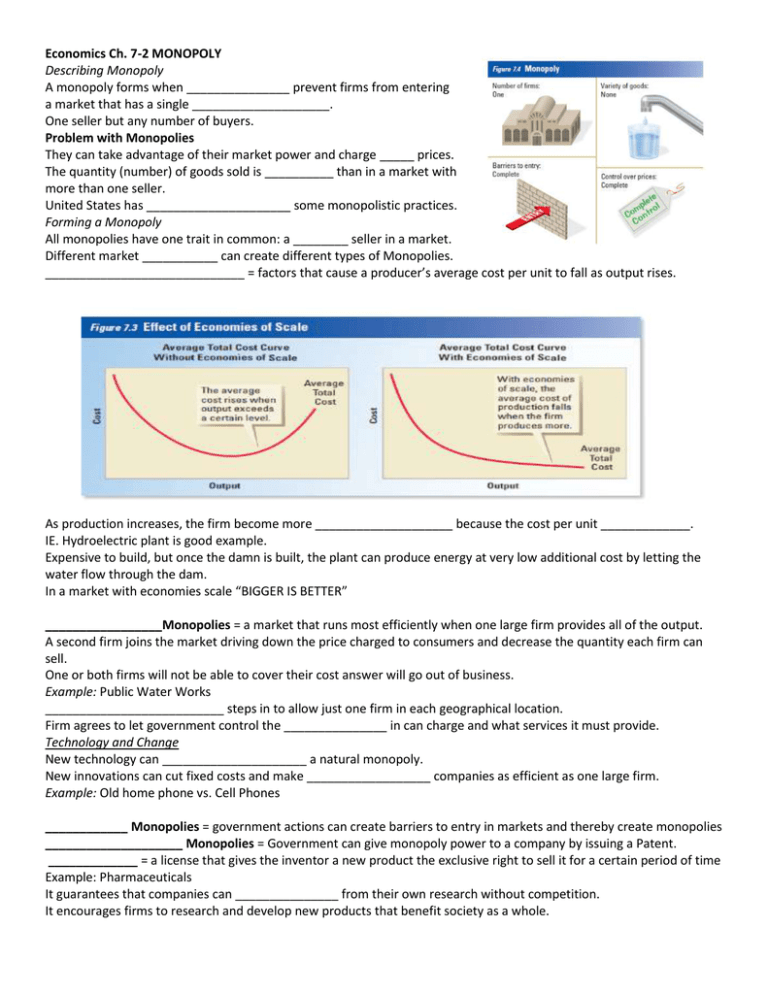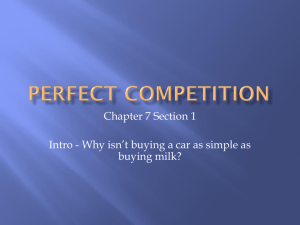Economics Ch. 7-2 MONOPOLY Describing Monopoly A monopoly
advertisement

Economics Ch. 7-2 MONOPOLY Describing Monopoly A monopoly forms when _______________ prevent firms from entering a market that has a single ____________________. One seller but any number of buyers. Problem with Monopolies They can take advantage of their market power and charge _____ prices. The quantity (number) of goods sold is __________ than in a market with more than one seller. United States has _____________________ some monopolistic practices. Forming a Monopoly All monopolies have one trait in common: a ________ seller in a market. Different market ___________ can create different types of Monopolies. _____________________________ = factors that cause a producer’s average cost per unit to fall as output rises. As production increases, the firm become more ____________________ because the cost per unit _____________. IE. Hydroelectric plant is good example. Expensive to build, but once the damn is built, the plant can produce energy at very low additional cost by letting the water flow through the dam. In a market with economies scale “BIGGER IS BETTER” _________________Monopolies = a market that runs most efficiently when one large firm provides all of the output. A second firm joins the market driving down the price charged to consumers and decrease the quantity each firm can sell. One or both firms will not be able to cover their cost answer will go out of business. Example: Public Water Works __________________________ steps in to allow just one firm in each geographical location. Firm agrees to let government control the _______________ in can charge and what services it must provide. Technology and Change New technology can _____________________ a natural monopoly. New innovations can cut fixed costs and make __________________ companies as efficient as one large firm. Example: Old home phone vs. Cell Phones ____________ Monopolies = government actions can create barriers to entry in markets and thereby create monopolies ____________________ Monopolies = Government can give monopoly power to a company by issuing a Patent. _____________ = a license that gives the inventor a new product the exclusive right to sell it for a certain period of time Example: Pharmaceuticals It guarantees that companies can _______________ from their own research without competition. It encourages firms to research and develop new products that benefit society as a whole. Franchises and Licenses _________________________ = the right to sell a good or service within an exclusive market Example: A single firm gets to sell food in a national park. Or McDonalds owner has franchise rights. _________________________= a government issued right to operate a business Example: Radio, Television frequencies and Land. The Federal Communications Commission (FCC) issues license for individual radio and t.v. stations. Cities can select a single firm to own and manage all of their parking lots. Industrial Organizations Rare cases but the government allows the companies in an ______________ to restrict the number of firms in a market. Example Major League Baseball, NFL and other sports leagues restrict the number and location of their teams. MLB has an exemption from the anti-trust laws. Output Decisions Monopolies still face a limited choice- they can choose either output or price but not both. They try to ________ profits. Monopolies produce fewer goods at a higher price. The Monopolist’s Dilemma The Law of ___________________ (Buyers demand more of a good at lower prices and less at higher prices) Make less and sell at higher price but sell less or make more, sell more at lower price but make less profit per unit. Falling Marginal Revenue Marginal __________= the additional income from selling one more unit of a good; sometimes equal to the selling price Marginal ___________= the cost of producing one more unit of good In a Perfectly competitive market Marginal Revenue = selling price In a Monopoly Marginal Revenue = less than the selling price and can begin to lose profits after an increased number in production. Setting a Price Monopolies will set production level at where Marginal revenue = Marginal cost. This will determine the sale price. Profits Sales Price – Cost of production = Profits _____________________ = division of customers into groups based on how much they will pay for a good Monopoly sets price at max price of all buyers in the market then it will only sell to one willing customer willing to pay that much. Low price = gain lots of customers but lost profits from those willing to pay more. Can be practiced by those with Market Power. _______________________= the ability of a company to change prices and output like a monopolist. Targeted Discounts is a price discrimination practice. 1. Discounted airline fares. Based on when purchased, age, day of flight 2. Manufacturers’ rebate offers. Mail in rebate after purchase 3. Senior Citizen or Student discounts 4. Children Fly, Stay, or Eat for free promotions. Limits of Price Discrimination For It to work a market must meet 3 conditions 1. Some market power. Must have some control over prices. 2. Distinct _________________________ Groups 3. Difficult ____________________ (parks pass, something that must be consumed on the spot





